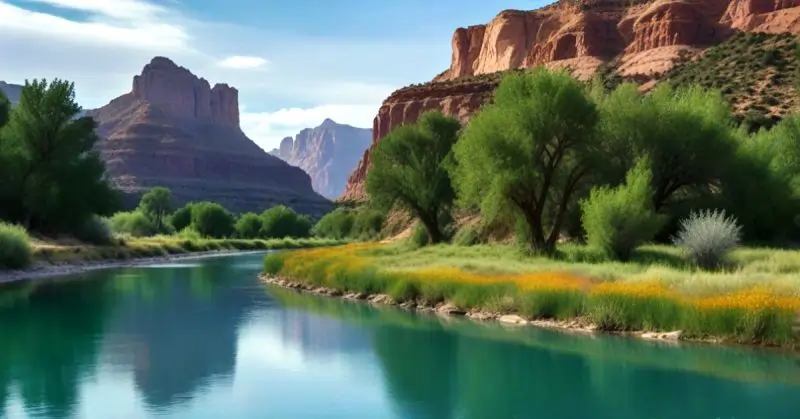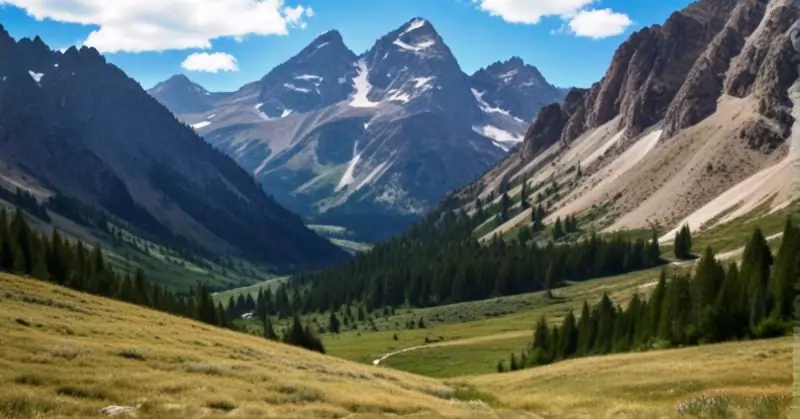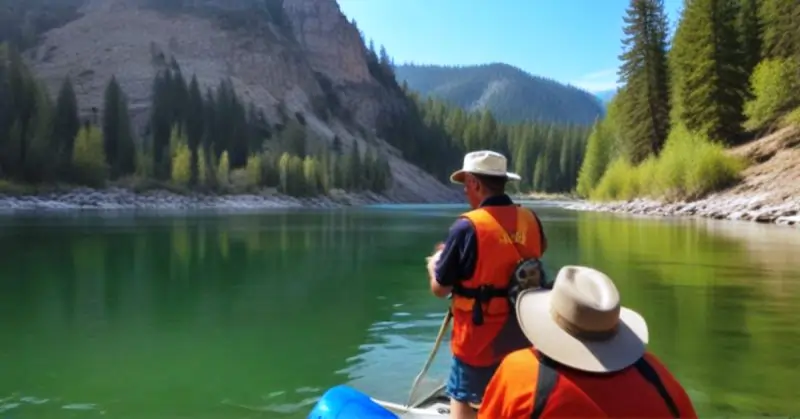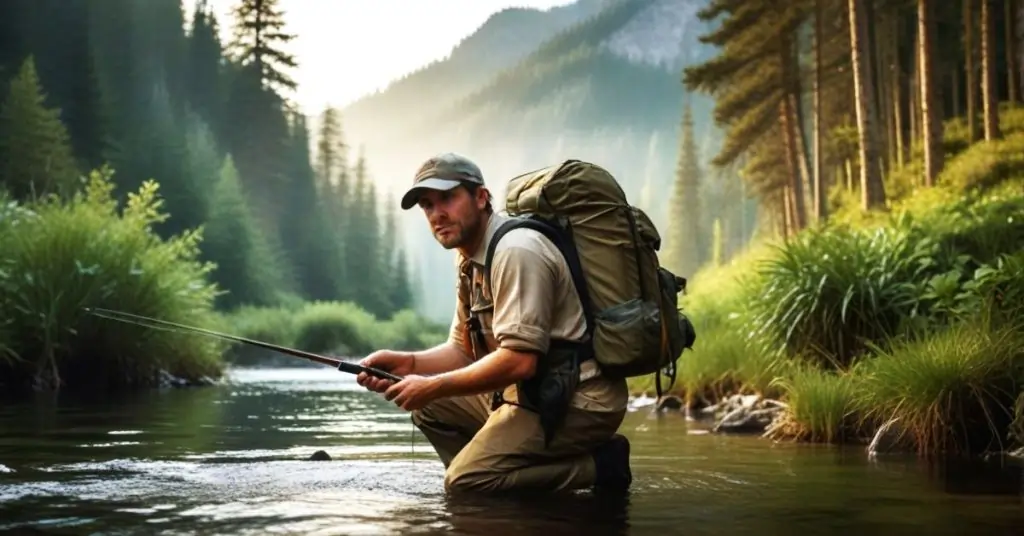Do you have visions of the ideal getaway where you may enjoy the tranquility of fly fishing along with the thrill of backpacking? Imagine yourself taking hikes through breathtaking scenery and stopping at fish-filled, glistening rivers. This special mix provides an incredible outdoor adventure, marrying the physical challenge of trekking with the quiet joy of fishing.
The best trails for fly fishing aren’t only close to water. They also boast beautiful scenery, lots of fish, and use eco-friendly methods to protect nature for the future. A great trail will test your hiking skills and make your fishing efforts worthwhile, offering different environments that are home to various types of fish.
In this guide, we’ll show you the top 5 backpacking fly fishing trails for 2024. We picked each trail for its beautiful paths, great fishing spots, and dedication to protecting nature. With these paths, it is sure to get an amazing experience, irrespective of your single trip or the exciting fishing experience. Enjoy the wonderful nature’s wonders.
Best Backpacking Fly Fishing Trails
The Green River Trail, Utah

Location & Access: The Green River Trail is located in northeastern Utah and is most accessible via the town of Dutch John. The best times to visit are from late spring through early fall when the weather is mild and the fish are active. Accessing the river is straightforward with several points along the route, including Little Hole and Browns Park.
Trail Details: The trail along the Green River spans approximately 7 miles from the Flaming Gorge Dam down to Little Hole. This moderately challenging path offers stunning views of the river and surrounding canyons. Hikers can enjoy a well-maintained trail that provides both a relaxing walk and a bit of adventure, as the terrain includes a mix of flat sections and gentle inclines.
Fishing Opportunities: The Green River is famed for its blue-ribbon trout fishing, particularly known for its healthy populations of rainbow and brown trout. Fly fishermen from around the world come here to cast their lines in the clear, cold waters. The river’s section just below the Flaming Gorge Dam is especially productive. The steady flow and deep pools create ideal conditions for large fish, making it a prime spot for catching trophy-sized trout.
Conservation Efforts: Local conservation efforts are robust along the Green River. Environmental groups and state agencies work closely to manage fish populations and preserve the river’s natural habitat. Initiatives include habitat restoration, monitoring water quality, and regulating fishing practices to ensure sustainability. These efforts help maintain the river’s health and biodiversity, securing its status as one of the top fly fishing destinations.
Nearby Facilities:
The area around the Green River is well-equipped to support visitors. There are several campsites available both at the Flaming Gorge Recreation Area and along the river’s course, offering basic amenities and some with full RV hookups. Emergency services are accessible, with ranger stations and first aid available. Additionally, various guide services operate in the area, providing expert advice, gear rentals, and guided fishing trips to enhance your fishing adventure.
Whether you’re a seasoned angler looking for your next big catch or a nature lover seeking a scenic hike, the Green River Trail in Utah offers a compelling blend of natural beauty and outdoor activity.
The Teton Crest Trail, Wyoming

Location & Access: The Teton Crest Trail is nestled in the spectacular Teton Range in Wyoming, part of the Grand Teton National Park. Access to the trail can be achieved through several trailheads, the most popular being the Granite Canyon entrance near Teton Village and the Phillips Pass Trailhead along Teton Pass. For those starting from inside the park, the String Lake Trailhead is a common choice. It’s advisable to check accessibility and road conditions with the national park service before planning your trip.
Trail Details: The Teton Crest Trail spans roughly 40 miles of high mountain terrain, offering hikers breathtaking vistas of the Teton Range and the surrounding valleys. This trail typically takes several days to complete and is known for its challenging elevation gains and the stunning beauty of its alpine environment. The path traverses alpine meadows, high passes, and glacial basins, providing a varied and rewarding hiking experience.
Fishing Opportunities: Along the Teton Crest Trail, anglers will find numerous high-alpine lakes and streams populated with cutthroat trout, brook trout, and mountain whitefish. Notable fishing spots include Marion Lake and Alaska Basin, where the clear waters provide excellent fly fishing opportunities in a serene setting. These remote locations offer a peaceful fishing experience far from the crowded spots closer to the park entrances.
Conservation Efforts: Conservation is a key focus in the area, with ongoing efforts to preserve the unique alpine and forest ecosystems of the Teton Range. The National Park Service, along with local conservation groups, works to maintain trail conditions, manage wildlife habitats, and educate visitors on the importance of minimizing their environmental impact. Initiatives often include trail restoration projects and wildlife monitoring programs to help protect the native species and their natural habitats.
Nearby Facilities: There are several backcountry campsites along the Teton Crest Trail, which require permits available from the Grand Teton National Park office. For those looking for more comfort, lodging options are available in Teton Village and other nearby towns such as Jackson. These areas offer a range of accommodations from rustic cabins to luxury hotels. Additionally, local regulations concerning wildlife, camping, and trail use are strictly enforced to ensure both hiker safety and environmental protection.
The Teton Crest Trail is an epic journey through some of Wyoming’s most awe-inspiring landscapes. It challenges hikers with its rugged terrain while rewarding them with some of the most picturesque views and excellent fly fishing spots in North America. Whether you’re trekking through its expansive trails or casting lines in its pristine waters, the Teton Crest Trail promises a truly unforgettable outdoor adventure.
The South Fork Flathead River, Montana

Location & Access: The South Fork Flathead River is located in the remote and rugged Bob Marshall Wilderness of northwest Montana. Accessing this pristine area is an adventure in itself, typically beginning from trailheads at the Hungry Horse Reservoir, such as the Spotted Bear or the Young’s Creek trailheads. These areas can be reached by road from Kalispell, Montana, though the final stretches are often on unpaved forest roads. Due to its remote nature, accessing the South Fork requires careful planning, including arranging for possible horse pack services or long hikes into the wilderness.
Trail Details: The terrain along the South Fork Flathead River is characterized by dense forests, alpine meadows, and steep, rocky slopes. Hikers and anglers should be prepared for backcountry conditions including fording streams, navigating through bear country, and dealing with sudden weather changes, which are common in high mountain environments. The trails here are less developed and require good physical condition and navigation skills.
Fishing Opportunities: The South Fork Flathead is renowned for its excellent fishing, particularly for native westslope cutthroat trout, which are abundant due to regulations that strictly limit non-native species. Prime fishing spots can be found throughout the river, but the stretches near the confluences with smaller tributaries, such as Young’s Creek and Danaher Creek, are particularly fruitful. The best times for fishing are from late June to mid-October, when the water levels are lower and the fish are more active.
Conservation Efforts: Conservation efforts in the South Fork Flathead region are robust, focusing on preserving the native fish populations and the overall health of the river ecosystem. These efforts include strict catch-and-release policies for certain species, limits on the use of motorized vehicles within certain distances of the river, and ongoing research projects monitoring fish populations and water quality. Additionally, the introduction of any non-native species is heavily regulated to protect the ecological balance.
Nearby Facilities: Facilities near the South Fork Flathead River are minimal and mostly geared towards wilderness experiences. There are several designated wilderness campsites along the river which provide basic amenities such as fire rings and pit toilets. These sites are managed by the U.S. Forest Service and require adherence to strict wilderness protocols to minimize human impact. For those seeking a bit more comfort, several forest service cabins are available for rent, but these must be reserved well in advance.
Exploring the South Fork Flathead River offers a true wilderness experience, where the rugged beauty of Montana’s landscape can be enjoyed alongside some of the best fly fishing in North America. This destination is ideal for experienced outdoor enthusiasts looking for adventure and solitude in one of the last untouched areas of the continental United States.
The Appalachian Trail, Maine Section

Location & Access: The Maine section of the Appalachian Trail is a rugged, remote area known for its challenging terrain and stunning natural beauty. The trail can be accessed from several points, with popular entry spots including Baxter State Park, home to Mount Katahdin, the northern terminus of the trail. Accessing the trail requires careful planning, especially since some sections require permits or advanced reservations, particularly in Baxter State Park due to high demand and limited entry quotas.
Trail Details: The Maine section of the Appalachian Trail stretches approximately 282 miles from the New Hampshire border to Mount Katahdin. It features some of the most remote and challenging segments of the entire trail, with numerous opportunities for fishing along its course. Notable areas ideal for fishing include the Hundred-Mile Wilderness, one of the most secluded sections of the trail, where streams and small lakes are abundant.
Fishing Opportunities: Anglers trekking this section of the Appalachian Trail can look forward to catching a variety of freshwater species. The waters here are teeming with brook trout and landlocked salmon, particularly in the larger lakes like Nahmakanta and Rainbow Lake. Smaller streams and ponds might yield catches of native brook trout, renowned for their vibrant colors, especially during the spring and fall seasons when the water temperatures are ideal.
Conservation Efforts: Conservation is a key focus along the Appalachian Trail in Maine, with numerous initiatives in place to promote sustainable fishing practices and protect the delicate ecosystem. Catch-and-release practices are encouraged, especially for native species like brook trout. Additionally, there are ongoing efforts to maintain the natural habitats and cleanliness of the water bodies through trail maintenance and education programs for hikers and anglers on minimizing their environmental impact.
Nearby Facilities: Resources along the Maine section of the Appalachian Trail are sparse, reflecting its remote nature. However, there are several lean-tos and designated camping areas that provide basic shelter and respite for through-hikers. Local outfitters and guide services are available in gateway communities such as Millinocket and Monson, where anglers can also find fishing supplies and local expertise. It’s advisable to fully prepare and carry necessary supplies as amenities directly on the trail are limited.
The Maine section of the Appalachian Trail offers a profoundly serene and immersive nature experience, combining challenging hikes with rewarding fishing opportunities in some of the most pristine environments in the Northeast. For the dedicated angler and hiker, this trail section provides a unique adventure where the beauty and solitude of Maine’s wilderness can be experienced firsthand.
The West Coast Trail, British Columbia

Location & Access: The West Coast Trail is one of the most famous trekking routes in Canada, located on Vancouver Island in British Columbia. It forms part of the Pacific Rim National Park Reserve, offering a unique blend of breathtaking coastal scenery and challenging hiking. Access to the trail is either from Bamfield to the north or Port Renfrew to the south, with mid-access available at Nitinaht Village via a water taxi. Travelers typically reach these points by car from Victoria or Vancouver, followed by a bus or shuttle service to the trailheads. Permits are required for all hikers, and reservations are highly recommended due to the trail’s popularity, especially during the peak season from May to September.
Trail Details: Spanning 75 kilometers, the West Coast Trail is a bucket-list experience for many hikers due to its rugged terrain and stunning ocean vistas. Originally established to aid shipwreck survivors along the coast, the trail now serves as a challenging adventure that includes ladders, cable cars, and ferry crossings. Hikers can expect to navigate sandy beaches, rocky shores, and dense coastal rainforests, encountering rich biodiversity and cultural heritage sites along the way.
Fishing Opportunities: The trail offers varied fishing experiences, with opportunities for both saltwater and freshwater fishing. Saltwater anglers can try their luck directly off the rocky coastal areas, targeting species like salmon, halibut, and rockfish. Freshwater streams along the trail are home to trout and salmon, particularly in the larger rivers that hikers will cross. Fishing licenses are required for both saltwater and freshwater fishing, and local regulations must be observed to ensure sustainable practice.
Conservation Efforts: Conservation is a critical aspect of managing the West Coast Trail, with ongoing efforts to protect local wildlife populations and their natural habitats. This includes monitoring of endangered species, restoring impacted areas, and implementing strict guidelines on camping and hiking to minimize human impact. Educational programs are also in place to inform visitors about the importance of conservation and responsible outdoor activities.
Nearby Facilities: The West Coast Trail is remote, with limited facilities directly on the trail. However, hikers have access to designated camping sites, pit toilets, and emergency buoys along the route. For more comprehensive services, including guide services, gear rentals, and emergency contacts, hikers should arrange these in advance through services in Bamfield, Port Renfrew, or Nitinaht Village. These locations also offer accommodation for before or after the hike, ranging from basic lodgings to more comfortable options.
Embarking on the West Coast Trail is an unforgettable adventure that combines physical challenges with the opportunity to engage directly with the raw and rugged beauty of British Columbia’s coastal environment. For those prepared to tackle its demanding paths, the trail offers a profound connection with nature, enriched by both fishing prospects and the satisfaction of navigating one of Canada’s most iconic outdoor experiences.
Essential Gear and Tips
Recommended Gear: When preparing for a trip that combines backpacking with fly fishing, selecting the right gear is crucial to ensure comfort, effectiveness, and minimal environmental impact. Here’s a breakdown of essential items:
Backpacking Gear:
- Backpack: Choose a comfortable, durable backpack with enough capacity to carry all your gear without being overly bulky.
- Tent: A lightweight, waterproof tent is essential for shelter.
- Sleeping Bag and Pad: Opt for a sleeping bag suitable for the climate and a compact, insulating pad.
- Cooking Gear: A portable stove, fuel, and lightweight cooking utensils.
- Navigation Tools: Maps, compass, and optionally a GPS device.
- Clothing: Weather-appropriate clothing and layers for sudden weather changes.
Fly Fishing Gear:
- Rods and Reels: A lightweight rod and reel combination suited for the type of fish you are targeting.
- Waders: Breathable waders are essential for staying dry and comfortable.
- Tackle: Various flies, lines, leaders, and tippets tailored to the local fish species.
- Fly Fishing Vest: Provides convenient storage for gear and quick access while fishing.
Leave No Trace and Respecting Fish Habitats:
- Follow Leave No Trace Principles: Be mindful of your environment by packing out all trash, staying on designated trails, and camping at established sites.
- Handle Fish Carefully: Practice catch and release whenever possible. Use barbless hooks, handle fish with wet hands, and keep them in water as much as possible during release to minimize stress and injury.
- Avoid Disturbing the Environment: Be cautious not to trample vegetation or disturb the waterbed where fish spawn.
Safety and Emergency Preparedness:
- Inform Someone of Your Plan: Always let someone know your itinerary and expected return time.
- Emergency Kit: Carry a basic first aid kit along with items like a whistle, waterproof matches, and emergency blanket.
- Weather Awareness: Keep informed about the weather conditions and be prepared for changes.
- Water Safety: Always wear a life vest if you are wading in deep or fast-moving water.
- Wildlife Encounters: Know how to safely handle encounters with local wildlife, particularly in areas with bears or other potentially dangerous animals.
Additional Tips:
- Stay Hydrated: Carry enough water and know where you can safely refill along the trail.
- Pack Light and Right: Prioritize essential items to keep your pack light. Double-check your pack before you leave to ensure you have everything you need.
- Learn Local Regulations: Familiarize yourself with local fishing regulations and necessary permits to ensure compliance with conservation laws.
Equipped with the right gear and knowledge, you can enjoy a fulfilling and responsible adventure in the great outdoors, combining the joys of both backpacking and fly fishing.
FAQ on “Best Backpacking Fly Fishing Trails”
Q- Where is fly fishing the most popular?
A- Fly fishing is most popular in the United States, especially in regions like Montana and Colorado.
Q- What country is known for flying fish?
A- Barbados is well-known for its flying fish, which are a staple in local cuisine and culture.
Q- What is the best age to start fly fishing?
A- Children can start fly fishing effectively around the age of 10, when they can better handle the equipment and understand the techniques.
Q- What time is best to fly fish?
A- The best times for fly fishing are early morning and late evening when fish are most active due to lower light and cooler temperatures.
Conclusion
In conclusion, the trails we’ve looked at provide a special mix of hiking and fly fishing that any fan of these activities would love. These spots offer more than just the excitement of catching fish; they take you on a journey through some of the most stunning natural scenery out there. Each trail brings its adventure, featuring different environments and chances to deeply connect with nature.
As you plan your trips, remember to be gentle and take care of these natural areas. Exploring responsibly helps keep these beautiful places alive and open for future explorers. So, get your gear ready, head out, and enjoy the unique experience of mixing the challenges of backpacking with the peaceful joy of fly fishing.
